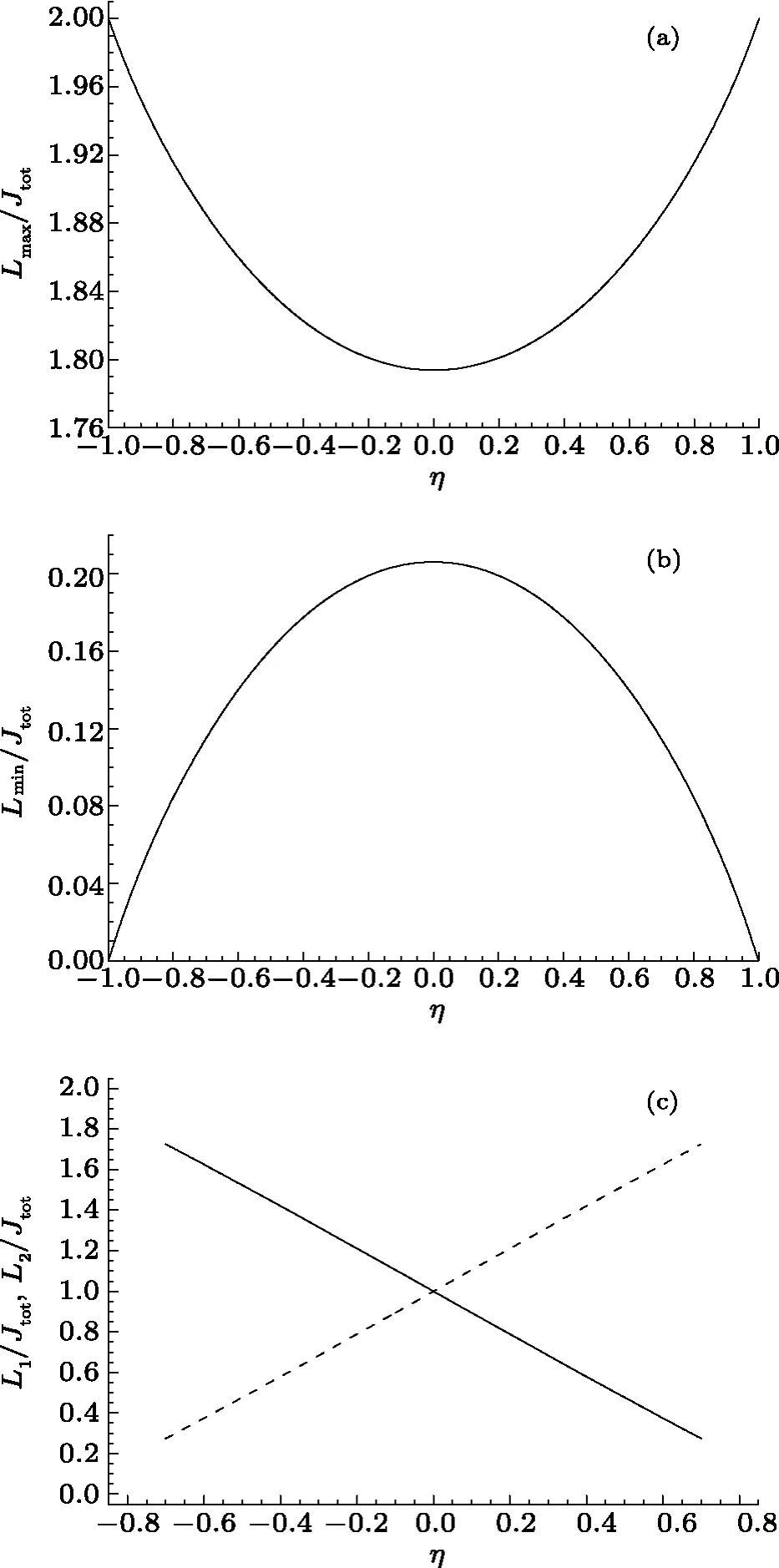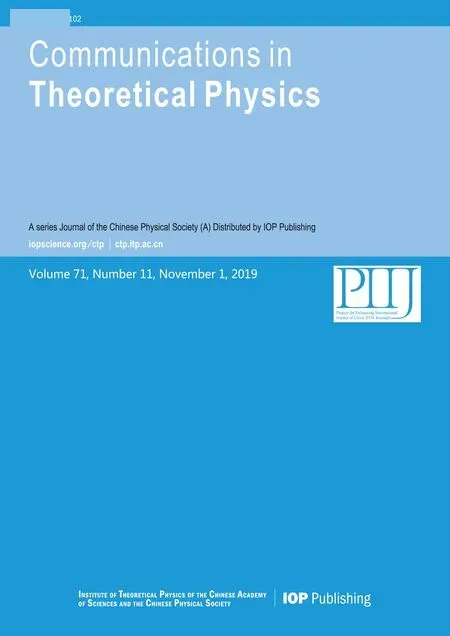Stability of Macroscopic Binary Systems∗
G.G.Adamian, N.V.Antonenko, H.Lenske, and V.V.Sargsyan
1Joint Institute for Nuclear Research, 141980 Dubna, Russia
2Institut für Theoretische Physik der Justus–Liebig–Universität, D–35392 Giessen, Germany
Abstract The Darwin instability effect in the binary systems (di-planets, di-stars, and di-galaxies) is analyzed within the model based on the Regge-like laws.All possible binary stars are found satisfying the Darwin instability condition that requires to search for other mechanism triggering the merger of the contact binary objects.New analytical formulas are obtained for the orbital rotation period and the relative distance between components of the binary system.The decreasing and increasing periods as functions of mass asymmetry are related, respectively, with the non-overlapping and overlapping stage of the binary object evolution.
Key words:Regge laws, binary stars and galaxies, Darwin instability effect
It is now commonly believed that the contact binaries,for example, the W UMa binaries, end their evolution by merging into a single star.[1]The dissipation of the orbital energy in the initial violent phase of merger resulted in the luminous red nova V1309 Sco observed in 2008.The luminous red novae have recently been identified as a distinct class of stellar transients.[2]They are characterized by relatively long outbursts with spectral distributions centered in the red, ranging in luminosities between classical novae and supernovae.The observations in the Optical Gravitational Lensing Experiment have revealed a shape of the light curve characteristic for contact binary system with an exponentially decreasing orbital period[3]and confirmed the earlier conjecture of Ref.[4]that the luminous red novae arise from merging contact binary stars.The spectacular case is KIC 9832227 which was predicted[5]to be merge in 2022, enlightening the sky as a red nova.The compact binaries composed of white dwarfs, neutron stars, and black holes eventually merge through gravitational wave emission.[6]
The details of specific mechanism, which triggers the merger of the contact binary components, are still controversial.[7−12]There is assumption[11]on the gradual mass transfer from less massive (and hence smaller radius) secondary star to the primary one (heavier star).This mass transfer is driven by the structural change in the secondary star caused by the energy received from the primary star.The contact is sustained by the magnetic braking or thermonuclear evolution.When the mass ratio is extreme enough for the Darwin instability,a merger starts that triggers the outburst in red novae.[3,13]The Darwin instability happens when the spin angular momentum of the system is more than one third of the orbital angular momentum.This instability plays a role once the mass ratio became small enough that the companion star can no longer keep the primary star synchronously rotating via the tidal interaction.For most of the primary massive stars, this occurs at the mass ratioq=M2/M1<0.1.[14]There is alternative scenario:[15]At first contact in a binary system, a brief, but intense, mass transfer sets in changing originally more massive star into less massive one.This process may oscillate until eventually a stable contact configuration is reached.Also the dynamic mass transfer without the Darwin instability[16]and mergers triggered by a tidal runaway based on a non-equilibrium response to tidal dissipation[17]have been investigated.Thus, there is a large quest for detailed observational and theoretical investigations.[15−17]
The Regge-theory proved to be very influential in the development of elementary-particle physics.The application of Regge ideas to astrophysics has shown that the spins of planets and stars are well described by the Regge-like law for a sphere (S ∼M4/3), while the spins of galaxies and clusters of galaxies obey the Regge-like law for a disk (S ∼M3/2).[18−20]In contrast to earlier semi-phenomenological approaches these expressions contain only fundamental constants as the parameters and are independent of any fitted empirical quantities.[18−20]In Refs.[18–20], the cosmic analog of the Chew-Frautschi plot with two important cosmological Eddington and Chandrasekhar points on it has been also constructed.
The aim of the present article is to study the Darwin instability effect in the binary star or galaxy by using the well-known model of Refs.[18–20]based on the Reggetheory.The total angular momentumJtotof binary system is the sum of orbital angular momentumLand the spinsSk(k=1,2) of the individual components:

TheJtotandSkare expressed using the Regge-like law for stars and planets (n=3) or galaxies (n=2):

and


and

respectively.Using the mass asymmetry (mass transfer) coordinateη=(M1−M2)/Minstead of massesand Eqs.(3)–(5), we derive

Atη=0 (the symmetric binary system), we have

and

For the symmetric binary star (planet) and binary galaxy withη=0, (S1+S2)/Lmax≈0.44 and 0.41, respectively.Atη=1, we have

and

As follows from last two expressions, for very asymmetric binaries, the ratios (S1+S2)/Lmax,minare almost independent of the value ofn.According to Ref.[14], the Darwin instability can occur when the binary mass ratio is very small [q=M2/M1<0.1]or the mass asymmetry is very large [η=(1−q)/(1 +q)>0.82].As seen in Fig.1, the ratios(S1+S2)/Lmaxand(S1+S2)/Lmincontinuously increases withηincreasing from 0 to 1.Because their absolute values are larger than 1/3, all possible binary stars (planets) or binary galaxies, independently of their mass asymmetryη,should have the Darwin instability(S1+S2≥)[13]and,correspondingly,should merge.However, the observations do not support this conclusion which probably means that there is no Darwin instability effect in such binary systems and,correspondingly,the mechanism of merger has other origin.Thus, it is necessary to search another mechanism that triggers the merging of the contact binary components.
Note that in the cases of antiparallel spins withL1=Jtot+S1−S2andL2=Jtot−S1+S2(Fig.1), the ratios |S2−S1|/L1and|S1−S2|/L2are larger thanfor the asymmetric binaries with|η|≥0.5.
As seen in Fig.2, the dependencies ofLmax,Lmin,L1,andL2on mass asymmetry have different behavior.The evolution of system in mass asymmetry (mass transfer)can increase or decrease the orbital angular momentum.For example, atη →0 the binary system has smallerL=Lmax.The observations of the dependence ofLonηmay be useful to distinguish the difference between the orientations of orbital and spin angular momenta.
Employing Eqs.(1)–(3) and results of Refs.[21, 23],we obtain new analytical formulas for the relative distance between the components of the binary

atRm >Rt=R1+R2(Rk,k=1,2, are the radii of binary components andRtis the touching distance) and

atRm ≤Rt.One can similarly derive the formulas for the orbital rotation period


atRm >Rtand

atRm < Rt.[21,23]Here,Gis the gravitational constant.The valuesϵ1=ϵ2=1 andϵ1=ϵ2=−1 correspond to the cases of antiparallel and parallel orbital and spin angular momenta.The valuesϵ1=−ϵ2=1 andϵ1=−ϵ2=−1 correspond to the cases of antiparallel spins.The observational data result in the relationshipRk=gMlkbetween the radius and mass of the star, where the constantsl=andg=(M⊙andR⊙are mass and radius of the Sun)[24]and the galaxy, where the constantldepending on mass is in the interval[22,25]As seen in Fig.3, atRm >Rt,

Fig.1 The calculated ratios (S1 + S2)/Lmax (a), (S1 +S2)/Lmin (b), (S1 −S2)/L2 [solid line](c), and (S2 −S1)/L1[dashed line](c) as functions of mass asymmetry at n=3.In the cases of antiparallel spins(c), L1=Jtot+S1 −S2 and L2=Jtot −S1+S2.

Fig.2 The calculated ratios Lmax/Jtot (a), Lmin/Jtot (b),L2/Jtot [solid line](c), and L1/Jtot [dashed line](c) as functions of mass asymmetry at n=3.

orPorbdecreases.AtRm >Rt(Fig.3),the dependence ofPorbas a function of mass asymmetry has similar behavior in the cases when the orbital and spin angular momenta are antiparallel and parallel.In the case of antiparallel spins withL1=Jtot+S1−S2(L2=Jtot−S1+S2) andM1≥M2, the values ofRmandPorbdecrease (increase )withηgoing from 1 to 0 (Fig.4).AtRm ≤Rt(Fig.5),the value of

Fig.3 The calculated dimensionless relative distances Rdm [(a), (b)]and orbital rotation periods Pdorb [(c), (d)]as functions of mass asymmetry at Rm > Rt= R1 +R2 and n=3.The plots [(a), (c)]and [(b), (d)]correspond to the systems with the parallel and antiparallel orbital and spin angular momenta, respectively.

Fig.4 The calculated dimensionless relative distance Rdm (a) and orbital rotation period Pdorb (b) as functions of mass asymmetry in the cases of antiparallel spins with L1=Jtot+S1 −S2 (dashed line) and L2=Jtot −S1+S2 (solid line),n=3, and Rm >Rt=R1+R2.

Fig.5 The calculated dimensionless Rdm [(a), (b), (c)]and Pdorb [(d)]as functions of mass asymmetry at Rm ≤Rt=R1+R2, n=3, and l=2/3.The plots (a) and (b) correspond to the system with the parallel and antiparallel orbital and spin angular momenta, respectively.In the plot (c), the cases of antiparallel spins with L1=Jtot+S1 −S2 (dashed line) and L2=Jtot −S1+S2 (solid line) are presented.Note that the value of Pdorb does not depend on the orientations of orbital momentum and spins.

orPorbincreases with decreasing|η|and does not depend on orientations of orbital momentum and spins.In contrast, the distance

orRmdepends on the orientations of orbital momentum and spins.As seen in Fig.5, the dependenciesRdmat different orientations on mass asymmetry have various behavior.
In conclusion, within the model[18−20]based on the Regge-like laws, we have shown that all possible binary stars (planets) or binary galaxies, independently of their mass asymmetryη, satisfy the Darwin instability condition (S1+S2≥) which contradicts to the observations.This conclusion is not sensitive to the parameters of model.Therefore, one should search for other mechanism that triggers the merger of the contact binary components.
Employing the Regge-like laws, we have derived the new analytical formulas for the relative distance and orbital rotation period of the binary system, which depend on the total massM, mass asymmetryη, and the fundamental constantsG,,mp.We have predicted that decreasing and increasing periods as functions of mass asymmetry (mass transfer) are related, respectively, with the non-overlapping (Rm > R1+R2) and overlapping(Rm ≤R1+R2) stage of the binary object evolution.
 Communications in Theoretical Physics2019年11期
Communications in Theoretical Physics2019年11期
- Communications in Theoretical Physics的其它文章
- Structure, Electronic, and Mechanical Properties of Three Fully Hydrogenation h-BN:Theoretical Investigations∗
- Polarized Debye Sheath in Degenerate Plasmas∗
- Absorption Enhancement of Ultrathin Crystalline Silicon Solar Cells with Dielectric Si3N4 Nanostructures∗
- Fractional Angular Momentum of an Atom on a Noncommutative Plane∗
- Similar Early Growth of Out-of-time-ordered Correlators in Quantum Chaotic and Integrable Ising Chains∗
- Neural-Network Quantum State of Transverse-Field Ising Model∗
